#scrapeMobileappdata
Text
Why Is Mobile App Data Scraping Important for Businesses and Developers
Mobile App Data Scraping enables businesses, developers, and researchers to gather valuable insights and make informed decisions efficiently.
know more :
https://www.retailscrape.com/mobile-app-data-scraping-for-businesses-and-developers.php
#MobileAppDataScraping#Mobileappdatacollection#Mobileappdatascraper#ScrapeMobileappdata#Mobileappdataextrection#iOSappscraping
0 notes
Text
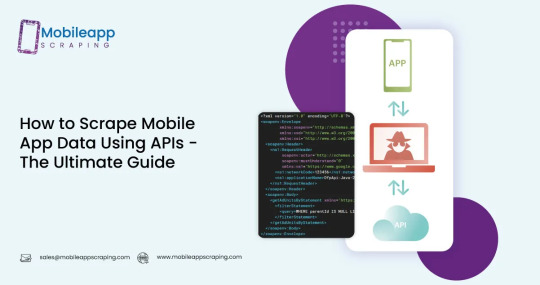
know more:
https://medium.com/@ridz.2811/how-to-scrape-mobile-app-data-using-apis-the-ultimate-guide-64a074d6864d
0 notes
Text
How to Scrape Mobile App Data Using APIs - The Ultimate Guide
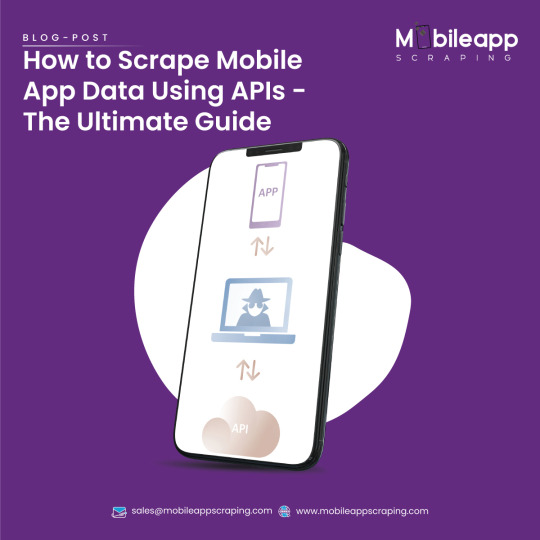
This blog is an ultimate guide about scraping mobile app data using APIs that discusses all the important points.
Know more>>
0 notes
Text
How Web Scraping Is Used To Extract Mobile App Data On The Scale?
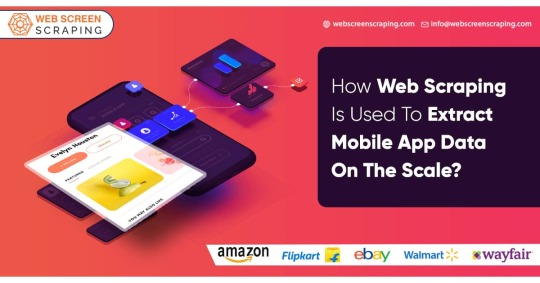
Introduction
Scraping data from various mobile apps is not something new, but it appears that various approaches have not scaled well. We are working hard at Web Screen Scraping on Mobile Apps Data Extraction on Scale, which is why we created this blog to provide relevant information on the issue.
Reverse Engineering
Now the question is, how are we going to do it? Assume you have to scrape data from a mobile app. Let's say you have an APK of an Android app and you want to scrape 500,000 points of data (UI screens) per day. How can you achieve this and what would it cost?
It's critical to figure out how a client communicates with servers, what protocol he uses, and how they send messages to one another.
Although this appears to be the most scalable and cost-effective option, it may only provide solutions for one application. What should we do if we desire to recurrence the process with more applications? What happens if an API is updated? As you can see, estimating the efforts it should make is difficult.
Following that, we used Android Emulator to install the APK, connect it to the proxy, and monitor the data.
After some hours, we were able to watch traffic from the clients to the server and even mimic calls to a server because everything was done over HTTPS.
Result
Reverse engineering is simple, to begin with, and appears to be the most cost-effective and scalable method of doing so. However, it may take a few lengthy days, as development charges are unpredictable, and don't always acquire the final product.
Appium or Selendroid
The situation is drastically different when utilizing tools like Selendroid or Appium. You may quickly write the situation you wish to test and have it run automatically over and over again. We choose to use Appium in conjunction with Android Emulator.
These have a reputation for being difficult to work with for mobile development, but with the release of x86 emulators, things have begun to operate more smoothly, and it now feels as if the applications running on laptops are faster than the physical devices themselves.
Later, we created a Docker container with Ubuntu 16.04, Appium, and an Android x86 emulator to begin the test of how many of them we could run simultaneously.
So, assuming that one CPU can run one emulator, we'll need 700 CPUs to run 700 emulators! It's a significant demand, and it's also quite costly!
Result
Physical hardware always delivers good performance, but it's difficult to manage on a wide scale.
So, how do you avoid having to deal with physical hardware management?
Well. We can use AWS, which is a public cloud. When we applied this strategy to the cloud, however, things went drastically differently. Linux, Docker, AWS, and Android have all worked successfully together in the past, but not with an emulator. AWS EC2 provides you with a Virtual Machine, and Android Emulator is another Virtual Machine. To take advantage of hardware acceleration while utilizing an x86 Android emulator, the host machine must reveal this capability; however, Amazon, like any other public cloud, does not do so; instead, they use it to serve us with virtual machines, therefore we were unable to even launch an Android x86 emulator!
So, how did we go about doing that? We've already used Ravello.
Cloud Ravello
When running on a public cloud, the Ravello solution supports nested virtualization or Kernel-based Virtual Machines on the host computer.
It has made it possible for us to run x86 Android emulators on the cloud. We tried it and it worked as well, however in terms of performance, the process took three times as long as on physical machines, and the situation worsened as more emulators were used.
Result
The Ravello Cloud solution is functional; however, its performance is lacking.
Cloud Genymotion
The Genymotion Cloud, which offers Android Machine Images (AMI) for Amazon EC2, is another option.
As a result, instead of obtaining a Windows or Ubuntu VM, you'll get an Android VM! It appeared to be the best public cloud-based option. We were able to run the scraping script on the physical hardware as well as the t2.small example (with 1 CPU + 2 GB RAM) using AMI.
The expense of this method is a problem because each instance besides the picture costs 0.149$ per hour, which adds up quickly when you have 700 Android simulators.
Result
Genymotion performs pretty well in the cloud and provides roughly the same work as running on a physical machine, but it's somewhat expensive when used on a large scale.
Bluestacks and Nox
These items were designed specifically for game players, but that doesn't mean we can't use them. To test it, we create a t2.medium Windows VM on AWS EC2.
The installation of Nox failed because the graphic card's driver was out of date. Even after overcoming this, more challenges arose, so we decided to use Bluestacks.
The installation of Bluestacks proceeded smoothly, and it performed admirably.
However, the issue was that we didn't come up with a way to run several Bluestacks applications on the cloud within our Virtual Machine, and our APK test didn't perform well on it either, possibly because Bluestacks operates in tablet mode.
Result
Bluestacks performed incredibly well on the virtual machines, it's free, and it's even visible over ADB, which means we can run tests of Appium on it. However, it can only run on Mac or Windows, and you can only run one instance at a time, and it only works in Tablet mode.
Certain optimizations can assist in speeding the time it takes to scrape the data when using one of the emulator options. To name a few, Use landing URLs, deep links, and other techniques if possible. When used on powerful PCs, the app speed may be faster than on the actual device.
Conclusion
To summarize, if you need to Scrape Mobile Apps Data on a large scale, and reverse engineering performs well and meets your needs, then go for it because Web Screen Scraping claims it is the most cost-effective and scalable method.
Other options for using an Android emulator are limited, and the results are prohibitively expensive. If you have any other ideas for scraping mobile apps on a large scale, please share them with us.
Looking for Mobile app data scraping services? Contact Web Screen Scraping today or request a quote!
0 notes
Text
Mobile App Data Scraping Services | iOS and Android App Scraping

Retailgators provide the Best Mobile App Data Scraping Services in the USA, Australia, and the UK to extract or scrape Mobile App data. Get professional Mobile App Data scraper like iOS and Android App Scraping at affordable prices.
www.retailgators.com/mobile-app-scraping-service.php
1 note
·
View note
Link
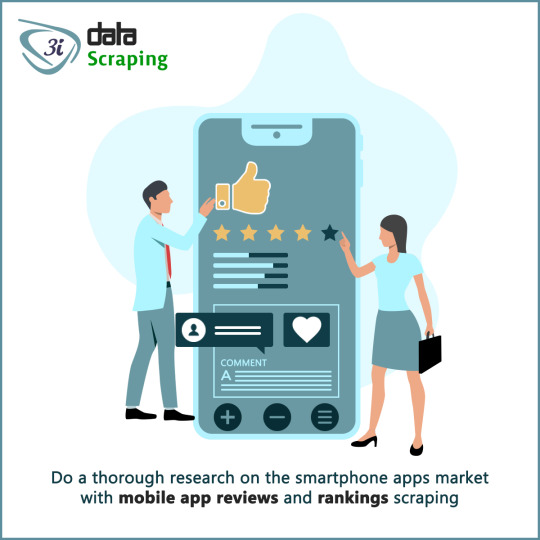
Scrape App Reviews and Rankings
The mobile application market has already become immense and it’s getting bigger and bigger. Getting a business mobile application has become very important these days.
In case, you have any plans of launching new android apps, it’s an extremely good idea of doing some research initially. Not sure where to start the research?
The finest place to initiate the research is different app stores with the main mobile OS. Google Play Store has over 2.2 million apps to select from and the Apple App Store is on the 2nd place with over 2 million mobile apps.
So, you can see there is ample valuable data accessible to mobile apps like categories, user reviews, star ratings, download counts, developer information and app ids.
If you wish to have detailed research about the mobile application market, you need to scrape app reviews and rankings with companies like 3i Data Scraping.
How to Scrape App Reviews and Rankings
Even though manual checking of details and features of some leading apps is easy, this won’t provide you the required insights and the real picture.
Manual collection of data isn’t a viable option anymore because the total number of mobile apps is in millions. That is where web scraper has a very important role to play.
Data scraping is the method of programming well-programmed web crawlers to crawl the data and extract the required information available on the Internet. You can use web scraping for extracting any openly available data on the Internet.
The data extracted will be saved in a document file, which can be used later for analysis.
#appscraping#mobileappscraping#mobile apps company#iosappscraping#androidappscraping#appdatascraping#scrapemobileappdata#mobileappreviewscraping#appreviewscraping#ApprankingScraping#mobileapprankdatascraping#3idatascraping#3idatascrapingservices#usa#india#canada
0 notes
Text
Why Is Mobile App Data Scraping Important for Businesses and Developers

Introduction
Mobile app data scraping refers to collecting valuable information and insights from mobile applications. As the mobile app ecosystem expands rapidly, accessing and analyzing data from these platforms becomes increasingly crucial for businesses, developers, and researchers. Mobile app data scraping allows for extracting various data points such as user reviews, ratings, app metadata, pricing information, user demographics, and in-app content. This data can provide valuable insights into user behavior, market trends, competitor analysis, and overall app performance. Mobile app data collection is handy for app developers seeking product feedback, businesses looking to understand consumer preferences and trends, and researchers analyzing the mobile app landscape. By leveraging mobile data scraping techniques and tools, stakeholders can make data-driven decisions, optimize their app strategies, and stay competitive in the ever-evolving mobile app market. However, it's essential to comply with relevant terms of service and legal regulations when scraping data from mobile apps to ensure ethical and responsible data usage.
Why Scrape Data from Mobile Apps?
Scraping data from mobile apps benefits various stakeholders, including businesses, developers, marketers, and researchers. Here are detailed points explaining why scraping data from mobile apps is advantageous:
Market Research: Accessing data from mobile apps provides valuable insights into market trends, user preferences, and competitor strategies. Analyzing app reviews, ratings, and download statistics helps businesses understand consumer behavior and market demand.
Competitor Analysis: Scraping data from competitor apps allows businesses to benchmark their performance against industry rivals. Analyzing competitor features, pricing strategies, and user feedback helps identify areas for improvement and competitive advantages.
User Feedback and Sentiment Analysis: Collecting user reviews and feedback from mobile apps using mobile app data scraper enables businesses to gauge user satisfaction, sentiment, and preferences. This feedback can enhance product features, address customer concerns, and improve overall user experience.
Product Development: Scrape data from mobile apps to gain valuable insights for product development. Analyzing user behavior, feature requests, and pain points helps prioritize product roadmap decisions and tailor offerings to meet customer needs.
Marketing Insights: Mobile app data scraping can uncover valuable marketing insights. Analyzing app install demographics, user engagement metrics, and advertising performance helps marketers optimize targeting, messaging, and spending.
Revenue Optimization: Accessing app pricing and monetization data helps businesses optimize revenue strategies. Analyzing in-app purchases, subscription models, and ad revenue trends enables businesses to maximize profitability.
User Acquisition Strategies: Scrutinizing mobile app data allows businesses to refine user acquisition strategies. Analyzing app store optimization (ASO) tactics, user acquisition channels, and conversion rates helps optimize marketing campaigns and drive app downloads.
Research and Analysis: Researchers and analysts can scrape mobile app data for academic studies, industry reports, and market analysis. Accessing anonymized data on user behavior, app usage patterns, and industry trends facilitates data-driven insights and decision-making.
Compliance and Risk Management: Monitoring mobile app data can help businesses identify compliance issues, security vulnerabilities, and brand reputation risks. Scrutinizing app permissions, data collection practices, and user privacy concerns ensures adherence to regulatory requirements and mitigates potential risks.
Innovation and Trends Tracking: Scraping data from mobile apps allows businesses to track emerging technologies, innovation trends, and user adoption patterns. Analyzing app categories, emerging startups, and disruptive technologies helps businesses stay ahead of the curve and identify new market opportunities.
Thus, scraping data from mobile apps offers many benefits, including market research, competitor analysis, user feedback analysis, product development insights, marketing optimization, revenue maximization, user acquisition strategies, research purposes, compliance management, and innovation tracking. By leveraging mobile app data scraping effectively, businesses can gain a competitive edge, drive innovation, and make informed decisions in the rapidly evolving mobile app landscape.
Is There Any Difference Between Scraping Mobile App Data and E-commerce Web Scraping?
Yes, there are several differences between scraping e-commerce mobile app data and e-commerce web Scraping:
Data Source: Mobile app data is sourced directly from mobile applications, typically accessed via APIs or reverse-engineering app protocols. Website data, on the other hand, is extracted from websites using web scraping techniques such as HTML parsing.
Data Structure: Mobile app data often follows a different structure from website data. Mobile app data may be organized in JSON or XML formats, while website data is typically structured using HTML and CSS.
Access Method: Mobile app data scraping may require interacting with APIs or analyzing network traffic while scraping website data involves sending HTTP requests and parsing HTML content.
Authentication: It requires handling authentication mechanisms such as OAuth tokens or API keys, whereas website scraping may involve handling cookies, sessions, or CAPTCHA challenges.
Data Volume: It involves smaller datasets than website scraping, as mobile apps typically have a narrower focus and limited content than websites.
User Interaction: Mobile apps often require user interaction to access specific data, such as logging in or navigating through app screens, whereas website scraping can be automated without user interaction.
Data Representation: Mobile app data may include additional metadata specific to mobile platforms, such as device information, app version, or user location, which may not be relevant in website data scraping.
Regulatory Considerations: Mobile app data scraping may be subject to additional legal and regulatory considerations, such as terms of service, app store guidelines, or data privacy regulations specific to mobile platforms.
While the fundamental principles of e-commerce data scraping apply to mobile apps and websites, there are notable differences in data source, structure, access method, authentication, data volume, user interaction, data representation, and regulatory considerations between scraping mobile app data and website data.
Steps to Scrape Android Mobile App Data
You need to follow a systematic approach to scrape Android mobile app data. Here are the detailed steps:
Identify Target App: Select the Android app from which you want to extract data. Choose apps with valuable data, such as user reviews, product details, or other relevant information.
Understand Data Structure: Analyze the app's data structure to determine the information you intend to scrape. This may involve examining the app's UI, inspecting network requests, or decompiling the app to understand its underlying data sources.
Install Android Developer Studio: Download and install Android Developer Studio, the official integrated development environment (IDE) for Android app development. It provides essential tools and resources for Android app development, including the Android SDK, emulator, and debugging features.
Install NodeJS: Install Node.js, a JavaScript runtime environment that provides the necessary tools and libraries for running JavaScript-based scraping scripts. Node.js is essential for executing scraping scripts and interacting with Android apps programmatically.
Install MITMProxy: MITMProxy (Man-In-The-Middle Proxy) is a powerful tool for intercepting, inspecting, and modifying network traffic. Install MITMProxy to intercept network requests made by the Android app and analyze the data exchanged between the app and the server.
Install APK-MITM: APK-MITM is a modified version of the Android app that routes its network traffic through MITMProxy. Install APK-MITM on your Android device or emulator to intercept and analyze network requests made by the app during runtime.
Write Automation Scripts: Develop automation scripts using tools such as Appium, UI Automator, or Selenium WebDriver with Appium. These tools allow you to interact with the Android app's UI elements and simulate user actions programmatically.
Handle Authentication: If the app requires authentication, handle login mechanisms within the automation scripts to access restricted data. It may involve automating login procedures or bypassing authentication checks using reverse engineering techniques.
Run the Scraper: Execute the automation scripts to interact with the Android app, simulate user actions, and extract desired data points. Monitor the scraping process for errors or issues and make necessary adjustments to ensure successful data extraction.
Analyze Data: Once data extraction is complete, analyze the scraped data to derive insights or integrate it into other systems for further processing. It may involve cleaning and preprocessing the data, performing statistical analysis, or visualizing it using tools like Python pandas, matplotlib, or Tableau.
By following these steps and using the mentioned tools, you can effectively scrape Android mobile app data for analysis, research, or other purposes and perform iOS app scraping. Remember to comply with relevant terms of service, legal regulations, and ethical considerations during the scraping process to ensure responsible data usage.
Conclusion
Mastering the art of scraping data from mobile apps opens a gateway to invaluable insights for various endeavors. Extracting data from mobile apps offers many opportunities for market research, competitive analysis, or enhancing user experiences. Researchers and businesses can unlock a trove of actionable data by diligently following the outlined steps and leveraging appropriate tools. However, it's crucial to conduct scraping ethically, adhere to legal regulations, and respect the terms of service. With responsible practices, the process becomes a means to collect data and a pathway to informed decision-making and sustainable growth in the dynamic mobile landscape.
Leverage the power of data-driven decisions with our Retail Scrape Company. Utilize consumer behavior insights, fine-tune pricing strategies, and surge ahead of competitors with real-time retail data scraping. Elevate your business with our comprehensive pricing optimization solutions and strategic decision support. Reach out today to revolutionize your retail ventures and maximize profits!
know more :
https://www.retailscrape.com/mobile-app-data-scraping-for-businesses-and-developers.php
#MobileAppDataScraping#Mobileappdatacollection#Mobileappdatascraper#ScrapeMobileappdata#Mobileappdataextrection#iOSappscraping
0 notes
Text
Why Is Mobile App Data Scraping Important for Businesses and Developers
Mobile App Data Scraping enables businesses, developers, and researchers to gather valuable insights and make informed decisions efficiently.
know more :
https://www.retailscrape.com/mobile-app-data-scraping-for-businesses-and-developers.php
#MobileAppDataScraping#Mobileappdatacollection#Mobileappdatascraper#ScrapeMobileappdata#Mobileappdataextrection#iOSappscraping
0 notes
Text
Why Is Mobile App Data Scraping Important for Businesses and Developers
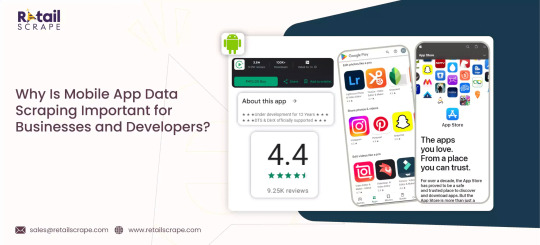
Introduction
Mobile app data scraping refers to collecting valuable information and insights from mobile applications. As the mobile app ecosystem expands rapidly, accessing and analyzing data from these platforms becomes increasingly crucial for businesses, developers, and researchers. Mobile app data scraping allows for extracting various data points such as user reviews, ratings, app metadata, pricing information, user demographics, and in-app content. This data can provide valuable insights into user behavior, market trends, competitor analysis, and overall app performance. Mobile app data collection is handy for app developers seeking product feedback, businesses looking to understand consumer preferences and trends, and researchers analyzing the mobile app landscape. By leveraging mobile data scraping techniques and tools, stakeholders can make data-driven decisions, optimize their app strategies, and stay competitive in the ever-evolving mobile app market. However, it's essential to comply with relevant terms of service and legal regulations when scraping data from mobile apps to ensure ethical and responsible data usage.
Why Scrape Data from Mobile Apps?
Scraping data from mobile apps benefits various stakeholders, including businesses, developers, marketers, and researchers. Here are detailed points explaining why scraping data from mobile apps is advantageous:
Market Research: Accessing data from mobile apps provides valuable insights into market trends, user preferences, and competitor strategies. Analyzing app reviews, ratings, and download statistics helps businesses understand consumer behavior and market demand.
Competitor Analysis: Scraping data from competitor apps allows businesses to benchmark their performance against industry rivals. Analyzing competitor features, pricing strategies, and user feedback helps identify areas for improvement and competitive advantages.
User Feedback and Sentiment Analysis: Collecting user reviews and feedback from mobile apps using mobile app data scraper enables businesses to gauge user satisfaction, sentiment, and preferences. This feedback can enhance product features, address customer concerns, and improve overall user experience.
Product Development: Scrape data from mobile apps to gain valuable insights for product development. Analyzing user behavior, feature requests, and pain points helps prioritize product roadmap decisions and tailor offerings to meet customer needs.
Marketing Insights: Mobile app data scraping can uncover valuable marketing insights. Analyzing app install demographics, user engagement metrics, and advertising performance helps marketers optimize targeting, messaging, and spending.
Revenue Optimization: Accessing app pricing and monetization data helps businesses optimize revenue strategies. Analyzing in-app purchases, subscription models, and ad revenue trends enables businesses to maximize profitability.
User Acquisition Strategies: Scrutinizing mobile app data allows businesses to refine user acquisition strategies. Analyzing app store optimization (ASO) tactics, user acquisition channels, and conversion rates helps optimize marketing campaigns and drive app downloads.
Research and Analysis: Researchers and analysts can scrape mobile app data for academic studies, industry reports, and market analysis. Accessing anonymized data on user behavior, app usage patterns, and industry trends facilitates data-driven insights and decision-making.
Compliance and Risk Management: Monitoring mobile app data can help businesses identify compliance issues, security vulnerabilities, and brand reputation risks. Scrutinizing app permissions, data collection practices, and user privacy concerns ensures adherence to regulatory requirements and mitigates potential risks.
Innovation and Trends Tracking: Scraping data from mobile apps allows businesses to track emerging technologies, innovation trends, and user adoption patterns. Analyzing app categories, emerging startups, and disruptive technologies helps businesses stay ahead of the curve and identify new market opportunities.
Thus, scraping data from mobile apps offers many benefits, including market research, competitor analysis, user feedback analysis, product development insights, marketing optimization, revenue maximization, user acquisition strategies, research purposes, compliance management, and innovation tracking. By leveraging mobile app data scraping effectively, businesses can gain a competitive edge, drive innovation, and make informed decisions in the rapidly evolving mobile app landscape.
Is There Any Difference Between Scraping Mobile App Data and E-commerce Web Scraping?
Yes, there are several differences between scraping e-commerce mobile app data and e-commerce web Scraping:
Data Source: Mobile app data is sourced directly from mobile applications, typically accessed via APIs or reverse-engineering app protocols. Website data, on the other hand, is extracted from websites using web scraping techniques such as HTML parsing.
Data Structure: Mobile app data often follows a different structure from website data. Mobile app data may be organized in JSON or XML formats, while website data is typically structured using HTML and CSS.
Access Method: Mobile app data scraping may require interacting with APIs or analyzing network traffic while scraping website data involves sending HTTP requests and parsing HTML content.
Authentication: It requires handling authentication mechanisms such as OAuth tokens or API keys, whereas website scraping may involve handling cookies, sessions, or CAPTCHA challenges.
Data Volume: It involves smaller datasets than website scraping, as mobile apps typically have a narrower focus and limited content than websites.
User Interaction: Mobile apps often require user interaction to access specific data, such as logging in or navigating through app screens, whereas website scraping can be automated without user interaction.
Data Representation: Mobile app data may include additional metadata specific to mobile platforms, such as device information, app version, or user location, which may not be relevant in website data scraping.
Regulatory Considerations: Mobile app data scraping may be subject to additional legal and regulatory considerations, such as terms of service, app store guidelines, or data privacy regulations specific to mobile platforms.
While the fundamental principles of e-commerce data scraping apply to mobile apps and websites, there are notable differences in data source, structure, access method, authentication, data volume, user interaction, data representation, and regulatory considerations between scraping mobile app data and website data.
Steps to Scrape Android Mobile App Data
You need to follow a systematic approach to scrape Android mobile app data. Here are the detailed steps:
Identify Target App: Select the Android app from which you want to extract data. Choose apps with valuable data, such as user reviews, product details, or other relevant information.
Understand Data Structure: Analyze the app's data structure to determine the information you intend to scrape. This may involve examining the app's UI, inspecting network requests, or decompiling the app to understand its underlying data sources.
Install Android Developer Studio: Download and install Android Developer Studio, the official integrated development environment (IDE) for Android app development. It provides essential tools and resources for Android app development, including the Android SDK, emulator, and debugging features.
Install NodeJS: Install Node.js, a JavaScript runtime environment that provides the necessary tools and libraries for running JavaScript-based scraping scripts. Node.js is essential for executing scraping scripts and interacting with Android apps programmatically.
Install MITMProxy: MITMProxy (Man-In-The-Middle Proxy) is a powerful tool for intercepting, inspecting, and modifying network traffic. Install MITMProxy to intercept network requests made by the Android app and analyze the data exchanged between the app and the server.
Install APK-MITM: APK-MITM is a modified version of the Android app that routes its network traffic through MITMProxy. Install APK-MITM on your Android device or emulator to intercept and analyze network requests made by the app during runtime.
Write Automation Scripts: Develop automation scripts using tools such as Appium, UI Automator, or Selenium WebDriver with Appium. These tools allow you to interact with the Android app's UI elements and simulate user actions programmatically.
Handle Authentication: If the app requires authentication, handle login mechanisms within the automation scripts to access restricted data. It may involve automating login procedures or bypassing authentication checks using reverse engineering techniques.
Run the Scraper: Execute the automation scripts to interact with the Android app, simulate user actions, and extract desired data points. Monitor the scraping process for errors or issues and make necessary adjustments to ensure successful data extraction.
Analyze Data: Once data extraction is complete, analyze the scraped data to derive insights or integrate it into other systems for further processing. It may involve cleaning and preprocessing the data, performing statistical analysis, or visualizing it using tools like Python pandas, matplotlib, or Tableau.
By following these steps and using the mentioned tools, you can effectively scrape Android mobile app data for analysis, research, or other purposes and perform iOS app scraping. Remember to comply with relevant terms of service, legal regulations, and ethical considerations during the scraping process to ensure responsible data usage.
Conclusion
Mastering the art of scraping data from mobile apps opens a gateway to invaluable insights for various endeavors. Extracting data from mobile apps offers many opportunities for market research, competitive analysis, or enhancing user experiences. Researchers and businesses can unlock a trove of actionable data by diligently following the outlined steps and leveraging appropriate tools. However, it's crucial to conduct scraping ethically, adhere to legal regulations, and respect the terms of service. With responsible practices, the process becomes a means to collect data and a pathway to informed decision-making and sustainable growth in the dynamic mobile landscape.
Leverage the power of data-driven decisions with our Retail Scrape Company. Utilize consumer behavior insights, fine-tune pricing strategies, and surge ahead of competitors with real-time retail data scraping. Elevate your business with our comprehensive pricing optimization solutions and strategic decision support. Reach out today to revolutionize your retail ventures and maximize profits!
know more :
https://www.retailscrape.com/mobile-app-data-scraping-for-businesses-and-developers.php
#MobileAppDataScraping#Mobileappdatacollection#Mobileappdatascraper#ScrapeMobileappdata#Mobileappdataextrection#iOSappscraping
0 notes
Text
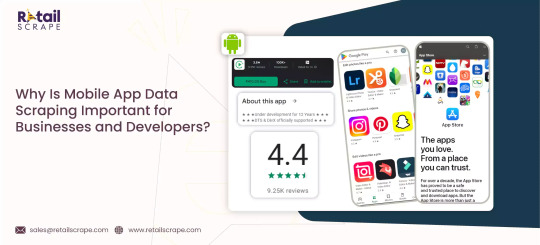
Why Is Mobile App Data Scraping Important for Businesses and Developers
Mobile App Data Scraping enables businesses, developers, and researchers to gather valuable insights and make informed decisions efficiently.
know more :
https://www.retailscrape.com/mobile-app-data-scraping-for-businesses-and-developers.php
#MobileAppDataScraping#Mobileappdatacollection#Mobileappdatascraper#ScrapeMobileappdata#Mobileappdataextrection#iOSappscraping
0 notes
Text
Why Is Mobile App Data Scraping Important for Businesses and Developers?
Mobile App Data Scraping enables businesses, developers, and researchers to gather valuable insights and make informed decisions efficiently.
know more :
https://www.retailscrape.com/mobile-app-data-scraping-for-businesses-and-developers.php
#MobileAppDataScraping#Mobileappdatacollection#Mobileappdatascraper#scrapeMobileappdata#Mobileappdataextrection#iOSappscraping
0 notes
Text
Why Is Mobile App Data Scraping Important for Businesses and Developers?
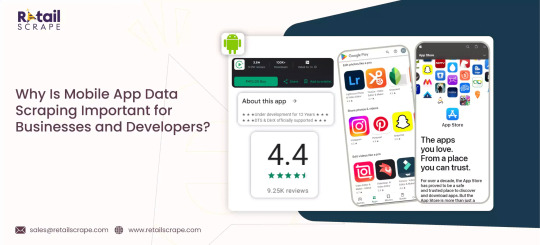
Introduction
Mobile app data scraping refers to collecting valuable information and insights from mobile applications. As the mobile app ecosystem expands rapidly, accessing and analyzing data from these platforms becomes increasingly crucial for businesses, developers, and researchers. Mobile app data scraping allows for extracting various data points such as user reviews, ratings, app metadata, pricing information, user demographics, and in-app content. This data can provide valuable insights into user behavior, market trends, competitor analysis, and overall app performance. Mobile app data collection is handy for app developers seeking product feedback, businesses looking to understand consumer preferences and trends, and researchers analyzing the mobile app landscape. By leveraging mobile data scraping techniques and tools, stakeholders can make data-driven decisions, optimize their app strategies, and stay competitive in the ever-evolving mobile app market. However, it's essential to comply with relevant terms of service and legal regulations when scraping data from mobile apps to ensure ethical and responsible data usage.
Why Scrape Data from Mobile Apps?
Scraping data from mobile apps benefits various stakeholders, including businesses, developers, marketers, and researchers. Here are detailed points explaining why scraping data from mobile apps is advantageous:
Market Research: Accessing data from mobile apps provides valuable insights into market trends, user preferences, and competitor strategies. Analyzing app reviews, ratings, and download statistics helps businesses understand consumer behavior and market demand.
Competitor Analysis: Scraping data from competitor apps allows businesses to benchmark their performance against industry rivals. Analyzing competitor features, pricing strategies, and user feedback helps identify areas for improvement and competitive advantages.
User Feedback and Sentiment Analysis: Collecting user reviews and feedback from mobile apps using mobile app data scraper enables businesses to gauge user satisfaction, sentiment, and preferences. This feedback can enhance product features, address customer concerns, and improve overall user experience.
Product Development: Scrape data from mobile apps to gain valuable insights for product development. Analyzing user behavior, feature requests, and pain points helps prioritize product roadmap decisions and tailor offerings to meet customer needs.
Marketing Insights: Mobile app data scraping can uncover valuable marketing insights. Analyzing app install demographics, user engagement metrics, and advertising performance helps marketers optimize targeting, messaging, and spending.
Revenue Optimization: Accessing app pricing and monetization data helps businesses optimize revenue strategies. Analyzing in-app purchases, subscription models, and ad revenue trends enables businesses to maximize profitability.
User Acquisition Strategies: Scrutinizing mobile app data allows businesses to refine user acquisition strategies. Analyzing app store optimization (ASO) tactics, user acquisition channels, and conversion rates helps optimize marketing campaigns and drive app downloads.
Research and Analysis: Researchers and analysts can scrape mobile app data for academic studies, industry reports, and market analysis. Accessing anonymized data on user behavior, app usage patterns, and industry trends facilitates data-driven insights and decision-making.
Compliance and Risk Management: Monitoring mobile app data can help businesses identify compliance issues, security vulnerabilities, and brand reputation risks. Scrutinizing app permissions, data collection practices, and user privacy concerns ensures adherence to regulatory requirements and mitigates potential risks.
Innovation and Trends Tracking: Scraping data from mobile apps allows businesses to track emerging technologies, innovation trends, and user adoption patterns. Analyzing app categories, emerging startups, and disruptive technologies helps businesses stay ahead of the curve and identify new market opportunities.
Thus, scraping data from mobile apps offers many benefits, including market research, competitor analysis, user feedback analysis, product development insights, marketing optimization, revenue maximization, user acquisition strategies, research purposes, compliance management, and innovation tracking. By leveraging mobile app data scraping effectively, businesses can gain a competitive edge, drive innovation, and make informed decisions in the rapidly evolving mobile app landscape.
Is There Any Difference Between Scraping Mobile App Data and E-commerce Web Scraping?
Yes, there are several differences between scraping e-commerce mobile app data and e-commerce web Scraping:
Data Source: Mobile app data is sourced directly from mobile applications, typically accessed via APIs or reverse-engineering app protocols. Website data, on the other hand, is extracted from websites using web scraping techniques such as HTML parsing.
Data Structure: Mobile app data often follows a different structure from website data. Mobile app data may be organized in JSON or XML formats, while website data is typically structured using HTML and CSS.
Access Method: Mobile app data scraping may require interacting with APIs or analyzing network traffic while scraping website data involves sending HTTP requests and parsing HTML content.
Authentication: It requires handling authentication mechanisms such as OAuth tokens or API keys, whereas website scraping may involve handling cookies, sessions, or CAPTCHA challenges.
Data Volume: It involves smaller datasets than website scraping, as mobile apps typically have a narrower focus and limited content than websites.
User Interaction: Mobile apps often require user interaction to access specific data, such as logging in or navigating through app screens, whereas website scraping can be automated without user interaction.
Data Representation: Mobile app data may include additional metadata specific to mobile platforms, such as device information, app version, or user location, which may not be relevant in website data scraping.
Regulatory Considerations: Mobile app data scraping may be subject to additional legal and regulatory considerations, such as terms of service, app store guidelines, or data privacy regulations specific to mobile platforms.
While the fundamental principles of e-commerce data scraping apply to mobile apps and websites, there are notable differences in data source, structure, access method, authentication, data volume, user interaction, data representation, and regulatory considerations between scraping mobile app data and website data.
Steps to Scrape Android Mobile App Data
You need to follow a systematic approach to scrape Android mobile app data. Here are the detailed steps:
Identify Target App: Select the Android app from which you want to extract data. Choose apps with valuable data, such as user reviews, product details, or other relevant information.
Understand Data Structure: Analyze the app's data structure to determine the information you intend to scrape. This may involve examining the app's UI, inspecting network requests, or decompiling the app to understand its underlying data sources.
Install Android Developer Studio: Download and install Android Developer Studio, the official integrated development environment (IDE) for Android app development. It provides essential tools and resources for Android app development, including the Android SDK, emulator, and debugging features.
Install NodeJS: Install Node.js, a JavaScript runtime environment that provides the necessary tools and libraries for running JavaScript-based scraping scripts. Node.js is essential for executing scraping scripts and interacting with Android apps programmatically.
Install MITMProxy: MITMProxy (Man-In-The-Middle Proxy) is a powerful tool for intercepting, inspecting, and modifying network traffic. Install MITMProxy to intercept network requests made by the Android app and analyze the data exchanged between the app and the server.
Install APK-MITM: APK-MITM is a modified version of the Android app that routes its network traffic through MITMProxy. Install APK-MITM on your Android device or emulator to intercept and analyze network requests made by the app during runtime.
Write Automation Scripts: Develop automation scripts using tools such as Appium, UI Automator, or Selenium WebDriver with Appium. These tools allow you to interact with the Android app's UI elements and simulate user actions programmatically.
Handle Authentication: If the app requires authentication, handle login mechanisms within the automation scripts to access restricted data. It may involve automating login procedures or bypassing authentication checks using reverse engineering techniques.
Run the Scraper: Execute the automation scripts to interact with the Android app, simulate user actions, and extract desired data points. Monitor the scraping process for errors or issues and make necessary adjustments to ensure successful data extraction.
Analyze Data: Once data extraction is complete, analyze the scraped data to derive insights or integrate it into other systems for further processing. It may involve cleaning and preprocessing the data, performing statistical analysis, or visualizing it using tools like Python pandas, matplotlib, or Tableau.
By following these steps and using the mentioned tools, you can effectively scrape Android mobile app data for analysis, research, or other purposes and perform iOS app scraping. Remember to comply with relevant terms of service, legal regulations, and ethical considerations during the scraping process to ensure responsible data usage.
Conclusion
Mastering the art of scraping data from mobile apps opens a gateway to invaluable insights for various endeavors. Extracting data from mobile apps offers many opportunities for market research, competitive analysis, or enhancing user experiences. Researchers and businesses can unlock a trove of actionable data by diligently following the outlined steps and leveraging appropriate tools. However, it's crucial to conduct scraping ethically, adhere to legal regulations, and respect the terms of service. With responsible practices, the process becomes a means to collect data and a pathway to informed decision-making and sustainable growth in the dynamic mobile landscape.
Leverage the power of data-driven decisions with our Retail Scrape Company. Utilize consumer behavior insights, fine-tune pricing strategies, and surge ahead of competitors with real-time retail data scraping. Elevate your business with our comprehensive pricing optimization solutions and strategic decision support. Reach out today to revolutionize your retail ventures and maximize profits!
know more :
https://www.retailscrape.com/mobile-app-data-scraping-for-businesses-and-developers.php
#MobileAppDataScraping#Mobileappdatacollection#Mobileappdatascraper#scrapeMobileappdata#Mobileappdataextrection#iOSappscraping
0 notes
Text
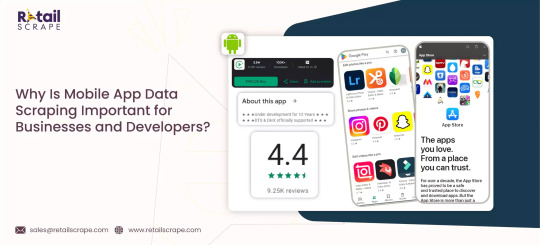
Why Is Mobile App Data Scraping Important for Businesses and Developers?
Mobile App Data Scraping enables businesses, developers, and researchers to gather valuable insights and make informed decisions efficiently.
know more :
https://www.retailscrape.com/mobile-app-data-scraping-for-businesses-and-developers.php
#MobileAppDataScraping#Mobileappdatacollection#Mobileappdatascraper#scrapeMobileappdata#Mobileappdataextrection#iOSappscraping
0 notes
Text

Why Is Mobile App Data Scraping Important for Businesses and Developers?
Mobile App Data Scraping enables businesses, developers, and researchers to gather valuable insights and make informed decisions efficiently.
know more :
https://www.retailscrape.com/mobile-app-data-scraping-for-businesses-and-developers.php
#MobileAppDataScraping#Mobileappdatacollection#Mobileappdatascraper#scrapeMobileappdata#Mobileappdataextrection#iOSappscraping
0 notes
Text
Why Is Mobile App Data Scraping Important for Businesses and Developers?

Introduction
Mobile app data scraping refers to collecting valuable information and insights from mobile applications. As the mobile app ecosystem expands rapidly, accessing and analyzing data from these platforms becomes increasingly crucial for businesses, developers, and researchers. Mobile app data scraping allows for extracting various data points such as user reviews, ratings, app metadata, pricing information, user demographics, and in-app content. This data can provide valuable insights into user behavior, market trends, competitor analysis, and overall app performance. Mobile app data collection is handy for app developers seeking product feedback, businesses looking to understand consumer preferences and trends, and researchers analyzing the mobile app landscape. By leveraging mobile data scraping techniques and tools, stakeholders can make data-driven decisions, optimize their app strategies, and stay competitive in the ever-evolving mobile app market. However, it's essential to comply with relevant terms of service and legal regulations when scraping data from mobile apps to ensure ethical and responsible data usage.
Why Scrape Data from Mobile Apps?
Scraping data from mobile apps benefits various stakeholders, including businesses, developers, marketers, and researchers. Here are detailed points explaining why scraping data from mobile apps is advantageous:
Market Research: Accessing data from mobile apps provides valuable insights into market trends, user preferences, and competitor strategies. Analyzing app reviews, ratings, and download statistics helps businesses understand consumer behavior and market demand.
Competitor Analysis: Scraping data from competitor apps allows businesses to benchmark their performance against industry rivals. Analyzing competitor features, pricing strategies, and user feedback helps identify areas for improvement and competitive advantages.
User Feedback and Sentiment Analysis: Collecting user reviews and feedback from mobile apps using mobile app data scraper enables businesses to gauge user satisfaction, sentiment, and preferences. This feedback can enhance product features, address customer concerns, and improve overall user experience.
Product Development: Scrape data from mobile apps to gain valuable insights for product development. Analyzing user behavior, feature requests, and pain points helps prioritize product roadmap decisions and tailor offerings to meet customer needs.
Marketing Insights: Mobile app data scraping can uncover valuable marketing insights. Analyzing app install demographics, user engagement metrics, and advertising performance helps marketers optimize targeting, messaging, and spending.
Revenue Optimization: Accessing app pricing and monetization data helps businesses optimize revenue strategies. Analyzing in-app purchases, subscription models, and ad revenue trends enables businesses to maximize profitability.
User Acquisition Strategies: Scrutinizing mobile app data allows businesses to refine user acquisition strategies. Analyzing app store optimization (ASO) tactics, user acquisition channels, and conversion rates helps optimize marketing campaigns and drive app downloads.
Research and Analysis: Researchers and analysts can scrape mobile app data for academic studies, industry reports, and market analysis. Accessing anonymized data on user behavior, app usage patterns, and industry trends facilitates data-driven insights and decision-making.
Compliance and Risk Management: Monitoring mobile app data can help businesses identify compliance issues, security vulnerabilities, and brand reputation risks. Scrutinizing app permissions, data collection practices, and user privacy concerns ensures adherence to regulatory requirements and mitigates potential risks.
Innovation and Trends Tracking: Scraping data from mobile apps allows businesses to track emerging technologies, innovation trends, and user adoption patterns. Analyzing app categories, emerging startups, and disruptive technologies helps businesses stay ahead of the curve and identify new market opportunities.
Thus, scraping data from mobile apps offers many benefits, including market research, competitor analysis, user feedback analysis, product development insights, marketing optimization, revenue maximization, user acquisition strategies, research purposes, compliance management, and innovation tracking. By leveraging mobile app data scraping effectively, businesses can gain a competitive edge, drive innovation, and make informed decisions in the rapidly evolving mobile app landscape.
Is There Any Difference Between Scraping Mobile App Data and E-commerce Web Scraping?
Yes, there are several differences between scraping e-commerce mobile app data and e-commerce web Scraping:
Data Source: Mobile app data is sourced directly from mobile applications, typically accessed via APIs or reverse-engineering app protocols. Website data, on the other hand, is extracted from websites using web scraping techniques such as HTML parsing.
Data Structure: Mobile app data often follows a different structure from website data. Mobile app data may be organized in JSON or XML formats, while website data is typically structured using HTML and CSS.
Access Method: Mobile app data scraping may require interacting with APIs or analyzing network traffic while scraping website data involves sending HTTP requests and parsing HTML content.
Authentication: It requires handling authentication mechanisms such as OAuth tokens or API keys, whereas website scraping may involve handling cookies, sessions, or CAPTCHA challenges.
Data Volume: It involves smaller datasets than website scraping, as mobile apps typically have a narrower focus and limited content than websites.
User Interaction: Mobile apps often require user interaction to access specific data, such as logging in or navigating through app screens, whereas website scraping can be automated without user interaction.
Data Representation: Mobile app data may include additional metadata specific to mobile platforms, such as device information, app version, or user location, which may not be relevant in website data scraping.
Regulatory Considerations: Mobile app data scraping may be subject to additional legal and regulatory considerations, such as terms of service, app store guidelines, or data privacy regulations specific to mobile platforms.
While the fundamental principles of e-commerce data scraping apply to mobile apps and websites, there are notable differences in data source, structure, access method, authentication, data volume, user interaction, data representation, and regulatory considerations between scraping mobile app data and website data.
Steps to Scrape Android Mobile App Data
You need to follow a systematic approach to scrape Android mobile app data. Here are the detailed steps:
Identify Target App: Select the Android app from which you want to extract data. Choose apps with valuable data, such as user reviews, product details, or other relevant information.
Understand Data Structure: Analyze the app's data structure to determine the information you intend to scrape. This may involve examining the app's UI, inspecting network requests, or decompiling the app to understand its underlying data sources.
Install Android Developer Studio: Download and install Android Developer Studio, the official integrated development environment (IDE) for Android app development. It provides essential tools and resources for Android app development, including the Android SDK, emulator, and debugging features.
Install NodeJS: Install Node.js, a JavaScript runtime environment that provides the necessary tools and libraries for running JavaScript-based scraping scripts. Node.js is essential for executing scraping scripts and interacting with Android apps programmatically.
Install MITMProxy: MITMProxy (Man-In-The-Middle Proxy) is a powerful tool for intercepting, inspecting, and modifying network traffic. Install MITMProxy to intercept network requests made by the Android app and analyze the data exchanged between the app and the server.
Install APK-MITM: APK-MITM is a modified version of the Android app that routes its network traffic through MITMProxy. Install APK-MITM on your Android device or emulator to intercept and analyze network requests made by the app during runtime.
Write Automation Scripts: Develop automation scripts using tools such as Appium, UI Automator, or Selenium WebDriver with Appium. These tools allow you to interact with the Android app's UI elements and simulate user actions programmatically.
Handle Authentication: If the app requires authentication, handle login mechanisms within the automation scripts to access restricted data. It may involve automating login procedures or bypassing authentication checks using reverse engineering techniques.
Run the Scraper: Execute the automation scripts to interact with the Android app, simulate user actions, and extract desired data points. Monitor the scraping process for errors or issues and make necessary adjustments to ensure successful data extraction.
Analyze Data: Once data extraction is complete, analyze the scraped data to derive insights or integrate it into other systems for further processing. It may involve cleaning and preprocessing the data, performing statistical analysis, or visualizing it using tools like Python pandas, matplotlib, or Tableau.
By following these steps and using the mentioned tools, you can effectively scrape Android mobile app data for analysis, research, or other purposes and perform iOS app scraping. Remember to comply with relevant terms of service, legal regulations, and ethical considerations during the scraping process to ensure responsible data usage.
Conclusion
Mastering the art of scraping data from mobile apps opens a gateway to invaluable insights for various endeavors. Extracting data from mobile apps offers many opportunities for market research, competitive analysis, or enhancing user experiences. Researchers and businesses can unlock a trove of actionable data by diligently following the outlined steps and leveraging appropriate tools. However, it's crucial to conduct scraping ethically, adhere to legal regulations, and respect the terms of service. With responsible practices, the process becomes a means to collect data and a pathway to informed decision-making and sustainable growth in the dynamic mobile landscape.
Leverage the power of data-driven decisions with our Retail Scrape Company. Utilize consumer behavior insights, fine-tune pricing strategies, and surge ahead of competitors with real-time retail data scraping. Elevate your business with our comprehensive pricing optimization solutions and strategic decision support. Reach out today to revolutionize your retail ventures and maximize profits!
know more :
https://www.retailscrape.com/mobile-app-data-scraping-for-businesses-and-developers.php
#MobileAppDataScraping#Mobileappdatacollection#Mobileappdatascraper#scrapeMobileappdata#Mobileappdataextrection#iOSappscraping
0 notes
Text
Why Is Mobile App Data Scraping Important for Businesses and Developers?
Mobile App Data Scraping enables businesses, developers, and researchers to gather valuable insights and make informed decisions efficiently.
know more :
https://www.retailscrape.com/mobile-app-data-scraping-for-businesses-and-developers.php
#MobileAppDataScraping#Mobileappdatacollection#Mobileappdatascraper#scrapeMobileappdata#Mobileappdataextrection#iOSappscraping
0 notes